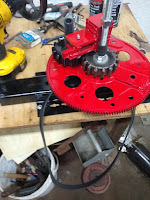Vol 2, Page 4, Dual Weight PIE Bench Test & Making the Drive Jackshaft

Dual Weight PIE Bench Test & Making the Drive Jackshaft Dual Weights (Maybe I'll take a pic without all of my workbench clutter in the background someday) Two days ago, as I was finishing up for the day, I decided to put both new weights on a single flexplate assembly at the same time. I really did this as a way to see the action and make observations of any interference between them. I was pleasantly surprised when the interaction appeared to be complimentary in nature. I was so pleased with the interaction that I decided to “spin” it up with the cordless drill. The amount of power being transmitted to the bench was remarkable, and because the flexplate was “balanced” out with the second planet assembly, I was able to run it at a somewhat higher speed without further modification. I observed the weights each contacting a stop (one inner, one outer) at virtually the same time and producing complimentary pulses. I was so pleased that I immediately cobbled together a way to...




